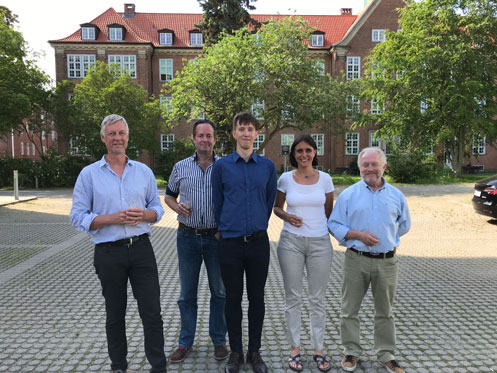Congratulations to Karl Nyman

Congratulations to Karl Nyman at Physics of Ice, Climate and Earth who successfully defended his PhD thesis Thursday 6 June 2019, and obtained the degree of Doctor of Philosophy.
Title and abstract of PhD thesis:
Title: Bifurcations of relaxation oscillations in models of the middle Pleistocene transition of glacial cycles
Abstract:
Since 2.7 million years ago Earth has witnessed waxing and waning of global ice volume called glacial cycles. Initially, these cycles had a period of about 40 thousand years, but around one million years ago the period increased to be closer to 100 thousand years long. This puzzling transition, called the middle Pleistocene transition (MPT) is the focus of this thesis. Studying the MPT is important, since only by understanding past climate well can we be confident in projections of climate into the future.
We study possible dynamical mechanisms behind the transition, meaning that we focus on transitions in equations describing conceptual models of the glacial cycles, rather than physical processes.
Results are presented in four parts. In the first part we clearly define a mechanism for the MPT which we term ramping with frequency locking (RFL). One novel contribution is to clarify that the abruptness of the MPT under RFL depends on a set of factors, some requiring stronger assumptions than others. Another contribution is to point out that the durations between major glacial terminations increased from ~40 thousand years to ~80 thousand years approximately 1200 thousand years ago, after which they increased to ~120 thousand years over the past two glacial cycles. Such a jump and subsequent slow increase in durations is consistent with RFL, unlike mechanisms in some other published models of glacial cycles. We also demonstrate that RFL is relevant for multi-frequency forcing and outline how to evaluate the potential for observing or including RFL in complex models.
In the second part, we classify all typical bifurcations in fast-slow systems with one fast variable that is ``infinitely'' faster than another, slow, variable. This classification is relevant for conceptual models of glacial cycles, since it lists all possible causes of the MPT given a clearly defined set of model assumptions. One such bifurcation was the cause of the MPT in (Ashwin and Ditlevsen, 2015).
In the third part, we investigate how certain self-sustained glacial cycle models respond to sinusoidal forcing whose amplitude and period varies over time (e.g. astronomical forcing). We invent a score which demonstrates that the observed sequence of durations between glacial terminations in a model run can, in some cases, be understood from the distribution of durations of the frozen model with fixed parameters. We are not aware of any other work which addresses the local-in-time influence of astronomical forcing on durations between terminations in glacial cycle models.
In the fourth part, we clarify the dynamical mechanism behind the MPT in the Paillard 1998 model. It is a particular form of RFL, in which glacial cycles after the MPT are frequency locked to the envelope of eccentricity. We construct a transparent model capturing this mechanism, which has previously only been expressed in words. We also show that the weakening of eccentricity from -1 million years to -600 thousand years plays a major role in reproducing an apparent abrupt increase in glacial cycle period, amplified by a set of specific model assumptions. This casts doubt on the generality of the particular form of RFL used to reproduce the MPT in the Paillard 1998 model.
